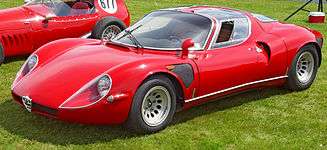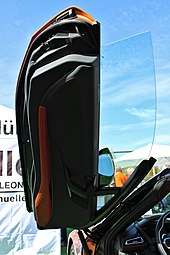Butterfly doors
Butterfly doors or vertical doors are a type of door sometimes seen on high-performance cars. They are similar to scissor doors. While scissor doors move straight up via hinge points at the bottom of the A-pillar, butterfly doors move up and out via hinges along the A-pillar.[1] This makes for easier entry/exit at the expense of requiring more opening space than needed for scissor doors.
The McLaren F1,[2] Alfa Romeo 33 Stradale, Saleen S7, Enzo Ferrari[3] and its non road-going version, the FXX, Toyota Sera/EXY-10, and the Mercedes-Benz SLR McLaren, among others, use butterfly doors. It was also a common feature for Group C and IMSA GTP/Camel Lights prototype racers as they incorporate teardrop tops which allows the driver to get in and out of the car more quickly than conventional and gullwing doors, especially in a cramped pitlane environment such as the pre-1991 Le Mans circuit. Since then, butterfly doors have been an adopted design of closed top sportscar racers, such as the Toyota GT-One, Bentley Speed 8 and more recently, the Peugeot 908 HDi FAP. The Toyota Sera, made between 1990 and 1995, was a limited-release car designed exclusively for the Japanese market which used this design. The Mercedes-Benz SLR McLaren Roadster was one of the few open top cars to use butterfly wing doors. This is made possible by having the doors hinged at the side of A-pillar instead of at top by the roof. The McLaren MP4-12C has a unique system where the butterfly doors do not use a top hinge meaning that the car can use frameless windows which allows for the car's upcoming convertible version to retain them.
 The Alfa Romeo 33 Stradale was the first car to use butterfly doors |
 1996 McLaren F1 with butterfly doors |
 BMW i8 Roadster butterfly door |
See also
References
- ↑ Keith Lane (2011). Automotive A-Z: Lane’s complete dictionary of automotive terms. ISBN 184584419X.
- ↑ NADA's AutoExec. 79. 2007. p. 68 https://books.google.com/books?id=7ucJAQAAMAAJ. Missing or empty
|title=(help) - ↑ Julia J. Quinlan (2012). Ferrari. p. 25. ISBN 1448876842.
External links
| Wikimedia Commons has media related to Automobiles with butterfly doors. |